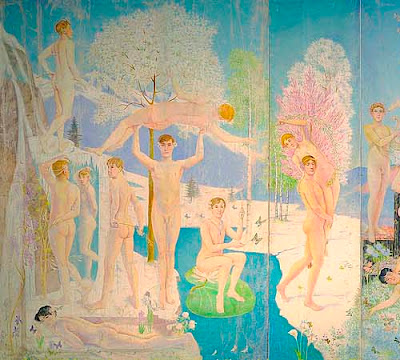— "Ne bouge pas ! Souris ! disait-il... "Sehr schön... Achtung, achtung... !" Il me disait que j'étais un petit faune du cortège de Dionysos, que j'étais un petit satyre avec une peau de bête sauvage sur les épaules, un petit satyre avec des cornes de chevreau sur la tête... "Achtung ! Achtung... !" Il signore Gloeden, Il Barone di Taormina, il mio caro amico Wilhelm était tellement sérieux et concentré derrière son appareil qu'il me fait rire...
— Carissimo Giovannino, tu es si beau... Sehr schön... Bello ragazzo... Tes yeux et ton sourire éblouissent mon appareil photo, tu es mon petit soleil, Giovannino mio..."
— Je me demande de quoi j'ai l'air, avec mes cheveux qu'il Signore Barone Professore Dottore Gloeden a mouillés puis mis en forme entre ses doigts... Je me demande à qui je souris, en regardant ainsi l'oeil de cet appareil photographique étrange...
— Giovannino mio, encore une photo, prego, questa e l'ultima, prego, prego !
— J'aimerais aller aux champs, gambader dans les collines et garder les chèvres de mon père comme un petit satyre grec, né de l'imagination d'il Signore Gloeden...
— Giovannino mio, mille grazie, perfetto !! perfetto ! Viele danke, bello !
— "Don't move ! Smile !", he said... "Sehr Schön... Achtung, achtung... !" He was telling me that I was a young faun dancing with Dionysus, that I was a young satyr, with a wild beast's skin on my shoulders,a young satyr with kid's horns on my head... "Achtung ! Achtung !" Il signore Gloeden, Il Barone di Taormina, il mio caro amico Wilhelm was so serious and so foccussed behind his camera that he made me laugh....
— Carrissimo Giovannino, you are so cute... Sehr schön... Bello ragzzo... Your eyes and your smile are dazzling my camera's lenses... You are my little sun, Giovannino mio !
— I am just wondering how I look like... Il Signore Barone Professore Dottore Gloeden moistened my hairs and gave them a weird form with his caressing fingers... I am wondering who I am smiling for, while looking at the lense of this strange photographic device...
— Giovannino mio, please another photograph, prego, questa e l'ultima, prego, prego !
— I would like to go to the wilderness, I would like prefer to wander through the hills while keeping a close watch on my father's goats... I am just a young Greek satyr, created by Il Signore Gloeden's imagination !
— Giovannino mio, mille grazie, perfetto !! perfetto ! Viele danke, bello !






























